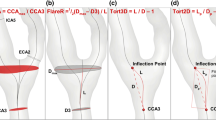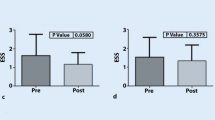Abstract
Objectives
To test the feasibility of four-dimensional (4D) flow MRI to quantify the systolic wall shear stress (WSSsystole) and oscillatory shear index (OSI) in high-grade internal carotid artery (ICA) stenosis before and after endarterectomy (CEA).
Methods
Twenty patients with ≥60 % ICA stenosis were prospectively and consequently included. Four-dimensional flow MRI was used to measure individual time-resolved 3D blood flow velocities. Segmental WSSsystole and OSI were derived at eight wall segments in analysis planes positioned along the ICA, common (CCA) and external carotid artery (ECA).
Results
Regional WSSsystole of all patients decreased after CEA (P < 0.05). Changes were most prominent at the ICA bulb but remained unchanged in the CCA and ECA. OSI was significantly lower after CEA in the lateral vessel walls (P < 0.05). For analysis planes at the stenosis in- and outlet, a reduction of mean WSSsystole by 32 % and 52 % (P < 0.001) and OSI distal to the stenosis (40 %, P = 0.01) was found after CEA.
Conclusions
Our findings show the potential of in vivo 4D flow MRI to quantify haemodynamic changes in wall shear stress even in patients with complex flow conditions.
Key Points
• The 4D flow MRI allows in vivo measurement of individual 3D blood flow.
• Regional wall shear stress can be derived from such 3D flow data.
• Even complex flow in high-grade internal carotid artery stenosis can be analysed.
• This technique could be valuable for future studies of carotid atherosclerosis.




Similar content being viewed by others
References
Brott TG, Hobson RW 2nd, Howard G et al (2010) Stenting versus endarterectomy for treatment of carotid-artery stenosis. N Engl J Med 363:11–23
Harloff A, Zech T, Wegent F, Strecker C, Weiller C, Markl M (2013) Comparison of blood flow velocity quantification by 4D flow MR imaging with ultrasound at the carotid bifurcation. AJNR Am J Neuroradiol. doi:10.3174/ajnr.A3419
Sachar R, Yadav JS, Roffi M et al (2004) Severe bilateral carotid stenosis: the impact of ipsilateral stenting on Doppler-defined contralateral stenosis. J Am Coll Cardiol 43:1358–1362
Aleksic M, Matoussevitch V, Heckenkamp J, Brunkwall J (2006) Changes in internal carotid blood flow after CEA evaluated by transit-time flowmeter. Eur J Vasc Endovasc Surg 31:14–17
Malek AM, Alper SL, Izumo S (1999) Hemodynamic shear stress and its role in atherosclerosis. JAMA 282:2035–2042
Cheng C, Tempel D, van Haperen R et al (2006) Atherosclerotic lesion size and vulnerability are determined by patterns of fluid shear stress. Circulation 113:2744–2753
Tomita H, Hagaman J, Friedman MH, Maeda N (2012) Relationship between hemodynamics and atherosclerosis in aortic arches of apolipoprotein E-null mice on 129S6/SvEvTac and C57BL/6J genetic backgrounds. Atherosclerosis 220:78–85
Lee SW, Antiga L, Spence JD, Steinman DA (2008) Geometry of the carotid bifurcation predicts its exposure to disturbed flow. Stroke 39:2341–2347
Markl M, Wegent F, Zech T et al (2010) In vivo wall shear stress distribution in the carotid artery: effect of bifurcation geometry, internal carotid artery stenosis, and recanalization therapy. Circ Cardiovasc Imaging 3:647–655
European Carotid Surgery Trialists’ Collaborative Group (1991) MRC European Carotid Surgery Trial: interim results for symptomatic patients with severe (70–99%) or with mild (0–29%) carotid stenosis. Lancet 337:1235–1243
Harloff A, Albrecht F, Spreer J et al (2009) 3D blood flow characteristics in the carotid artery bifurcation assessed by flow-sensitive 4D MRI at 3T. Magn Reson Med 61:65–74
Bock J, Kreher BW, Hennig J, Markl M (2007) Optimized pre-processing of time-resolved 2D and 3D phase contrast MRI data. Abstract. ISMRM May; Berlin, Germany. p 3138
Bock J, Frydrychowicz A, Stalder AF et al (2010) 3D phase contrast MRA and flow visualization in the thoracic aorta at 3T: feasibility and effect of standard and blood-pool contrast agents. Magn Reson Med 63:330–338
Stalder AF, Russe MF, Frydrychowicz A, Bock J, Hennig J, Markl M (2008) Quantitative 2D and 3D phase contrast MRI: optimized analysis of blood flow and vessel wall parameters. Magn Reson Med 60:1218–1231
Barker AJ, Markl M, Burk J et al (2012) Bicuspid aortic valve is associated with altered wall shear stress in the ascending aorta. Circ Cardiovasc Imaging 5:457–466
Lal BK, Beach KW, Roubin GS et al (2012) Restenosis after carotid artery stenting and endarterectomy: a secondary analysis of CREST, a randomised controlled trial. Lancet Neurol 11:755–763
Markl M, Wallis W, Harloff A (2011) Reproducibility of flow and wall shear stress analysis using flow-sensitive four-dimensional MRI. J Magn Reson Imaging 33:988–994
LaDisa JF Jr, Bowers M, Harmann L et al (2010) Time-efficient patient-specific quantification of regional carotid artery fluid dynamics and spatial correlation with plaque burden. Med Phys 37:784–792
Hayase H, Tokunaga K, Nakayama T et al (2011) Computational fluid dynamics of carotid arteries after carotid endarterectomy or carotid artery stenting based on postoperative patient-specific computed tomography angiography and ultrasound flow data. Neurosurgery 68:1096–1101
Harloff A, Markl M, Frydrychowicz A, Hennig J, Weiller C (2009) Diagnosing stroke aetiologies. Morphologic and functional analysis of the aorta and carotid arteries by MRI. Nervenarzt 80:929–940
Gallo D, Steinman DA, Bijari PB, Morbiducci U (2012) Helical flow in carotid bifurcation as surrogate marker of exposure to disturbed shear. J Biomech 45:2398–2404
Tate Q, Kim SE, Treiman G, Parker DL, Hadley JR (2012) Increased vessel depiction of the carotid bifurcation with a specialized 16-channel phased array coil at 3T. Magn Reson Med 69:1486–1493
Barker AJ, Lanning C, Shandas R (2010) Quantification of hemodynamic wall shear stress in patients with bicuspid aortic valve using phase-contrast MRI. Ann Biomed Eng 38:788–800
Acknowledgements
We thank Hansjörg Mast for performing all MRI measurements.
Andreas Harloff is supported by Deutsche Forschungsgemeinschaft grant no. HA 5399/3-1; Michael Markl is supported by NIH NHLBI grant R01HL115828; NUCATS Institute NIH grant UL1RR025741, and the Northwestern Memorial Foundation Dixon Translational Research Grants Initiative.
Disclosures
None of the authors has a conflict of interest related to this article.
Author information
Authors and Affiliations
Corresponding author
Rights and permissions
About this article
Cite this article
Harloff, A., Berg, S., Barker, A.J. et al. Wall shear stress distribution at the carotid bifurcation: influence of eversion carotid endarterectomy. Eur Radiol 23, 3361–3369 (2013). https://doi.org/10.1007/s00330-013-2953-4
Received:
Revised:
Accepted:
Published:
Issue Date:
DOI: https://doi.org/10.1007/s00330-013-2953-4




